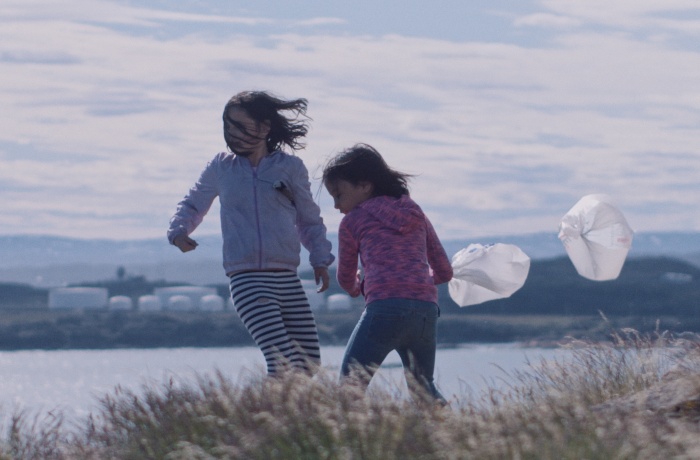
We conclude the announcements of this year's competition blocks with a review of the DOCU/WORLD international program created for the festival guide. The selection includes ten films by directors from around the world. A careful and insightful look at each of the films is in the text of journalist and film critic Dmytro Desiateryk.
The protagonists of We Will Not Fade Away are five teenagers who live in an area near the frontline in the Luhansk Region. Although the film was shot at different locations — in Zolote village and in Stanytsia Luhanska — their landscapes are unified in their recognisability and monotonousness. One- or two-story houses, a spoil tip as the highest vertical point, broken roads, poverty. Career prospects limited to the mines or the police academy. The choice of leisure activities also isn’t rich: an evening dance at the village club, hanging around railway tracks, an occasional firework display on a holiday, a Christmas tree, a sip of alcohol hidden from the adults. And regular, clearly audible cannonade, sometimes with a glow on the horizon. The war introduces an intrusive note which makes this routine even more unbearable; as one of the girls writes, “No future in Stanitsa.”
Nevertheless, the protagonists resist the quagmire with its smell of burning as best they can. Andriy digs around in various equipment, rides a vintage Soviet moped, dreams of a Harley-Davidson, hangs a portrait of Elon Musk as the master of the free internet in his workshop. Illia learns a dance with his classmates, takes gigs as a Santa Claus, and wants to become an actor. Ruslan writes and records rap tracks. Lera never goes anywhere without her photo camera. Liza paints watercolours at a properly serious level.
They are in a more or less constant conflict with the adults. Liza is annoyed by her art teacher and mom constantly repeating that the most important thing in life is to find a good husband. Illia’s mom doesn’t see him as an actor. Andriy’s father roughly and humiliatingly berates him for a minor technical mistake. And, of course, they, the ridiculed dreamers, are the ones who get an extraordinary chance to go on a trip to the Himalayas, which is organised by the sports commentator and traveller Valentyn Shcherbachov.
Stuzhytsia is a village that lies between Ukraine, Slovakia and Poland in the Carpathian Mountains. In Ukrainian the name of the village means something like ‘cold place’. The director, Maksym Melnyk, notes that what attracted him was the village’s location in a “pocket” between three borders: he wanted to see how people live there. He found three heroines for the film Three Women — in the literal sense of the word: farmer Hanna, biologist Nelia and postwoman Maria.
This list of occupations actually looks perfect. Socially equal in their lack of wealth, the three women represent all the levels of experience required to understand how it is to live here.
For Hanna, land is her work and fate; she is part of the landscape herself. When Maksym says in fascination: “How beautiful it is here!”, Hanna shrugs: “It’s just mountains.”
Nelia is a rational gaze, scientific exploration of details. She cannot live without the nearby National Park and tries to examine the place at the microlevel, literally digging into animal droppings or tracking bats. Nelia finds the hidden, the invisible which is at the bottom of the entire area’s very long food chains.
Maria is Stuzhnytsia’s connection to the outside world, she is the government's messenger carrying the good news in the form of pensions, and although the pensions are not big, the messenger must be happy. Maria is cheerful in nature, she enthusiastically takes a glass or two of cordial with her clients and finds the appropriate word for any situation.
Thus, starting from purely tourist curiosity, exploring Stuzhytsia step by step with these strong women, Melnyk eventually shapes a three-dimensional image of the reality he has found himself in. He examines the Carpathian landscapes in long shots with hyperrealistic accuracy, paints the picture of the villagers’ everyday, he pays attention to the animals and even insects; he looks into every floor of life, every level of being. He does not hide poverty, nor grief, nor joy. The result is a veritably anthropological film. And poetic as well.
In the last scene, all the valleys vanish in the clouds. Maybe it is the fog of oblivion, or maybe it is the “milk of a happy cow” of which Hanna said, “This land has its own truth.”
A still from the film Three Women
The Pawnshop begins with a scandal. Two men work on blowing up balloons. Wiesiek, the man on the left, a charismatic middle-aged gentleman, is on the phone trying to deflect a customer’s complaints about a blender they recently purchased. Tomek, the one on the right, a menacing young man covered in tattoos, makes snarky comments on the conversation without interrupting his work on the balloons. A brilliant comical episode from the very start. But compositionally it is a flash forward, a scene from the future. Now, however, we need to be shown what exactly these two do for a living.
Lukasz Kowalski’s feature debut is set in Bytom, a depressed mining town in Upper Silesia. No jobs, no prospects, kids chasing each other between shabby houses. Wiesiek and his girlfriend Jolanta, an assertive bleach blonde in her invariable fur coat, are running a pawnshop, which is abnormally large given the circumstances. The business brings zero profit because there is just nobody to buy their wares.
In fact, Kowalski did something that is rather difficult to do in the given circumstances: without trying to hide the factor of poverty, he still composes a true documentary comedy. Especially since all the characters carry a proper charge of poignancy and comedy within them in one way or another: in addition to Wiesiek, Tomek and Jola, it is also worth mentioning the beautiful emotional Agnieszka and Sandra, who is tenderly in love with Tomek. Everything this loser ensemble does, from minor repairs to an ostentatious presentation with a fashion show and hot dogs, is hilarious and unforgettable. Plus they all love one another with a kind of doomed force. As Jola puts it, “We are still together. Despite all the bad things, none of us can leave.”
The pawnshop itself is another character. It is a wild, even absurd mix of a museum, an art gallery, and a flea market. It seems like this whole mass of useless things are living their own lives, moving around, switching places or falling down regardless of their owners’ will. Essentially, the pawnshop is a metaphor for everything that is happening around it. Because all the poor and desperate souls from the area come here with hope for salvation or just to hear a kind word. They have seen better times, too, and they have also ended up in the pawnshop of existence, worn out from work and invisible to everyone. Sometimes you can barely tell them apart from the merchandise on the shelves. But Jola always has a kind word and a bowl of soup for them. Because “we are all a family.” The film turned out both sad and funny. True realism.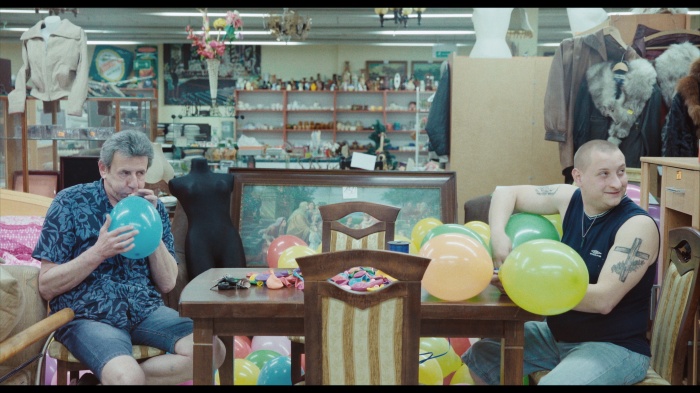
A still from the film The Pawnshop
“Is it possible to change the world and heal your wounds at the same time?” This is the first sentence of a book which Aaju Peter, a Greenland Inuit with a very difficult fate, is writing. When she was a child, a straight-As student, she was taken from her home village to Copenhagen — back then it was a widespread practice for assimilating indigenous children. An enormous trauma caused by forced separation motivated Aaju to go and live with Canadian Inuits when she came of age: she admits that she sees everything Danish as hostile.
The story told by filmmaker Lin Alluna in the film Twice Colonized, is incited by a tragedy: the suicide of Aaju’s son, who threw himself out the window. The protagonist starts a journey to understand why it happened to her and what to do now, when the balance of life has been disrupted again.
Alluna uses a lot of footage from the protagonist’s personal archive and from the times of her youth. Colonial policy was still flourishing in the West until relatively recently. Hence the claim about being colonised twice: Canada has also made quite a lot of effort to dissolve the indigenous people in the white English-speaking mass. Aaju also faces personal hardship: in addition to her son’s death, she also has to oppose her abusive partner whom she manages to leave only after a while.
But the unbreakable Inuit finds the resources within herself to fight and win on several fronts at once. She leaves her toxic husband, initiates and ensures the establishment of a forum for indigenous peoples at the European Union. And she writes the book Twice Colonized.
Lin Alluna does not employ any special directing tricks. She just shows Aaju as she is, giving this striking 58-year-old woman, who bounces around with the energy of an 18-year-old along with her grandchildren, space to open up to the fullest. In the last scene, Aaju dances against the background of the night sky, and it is the dance of a winner.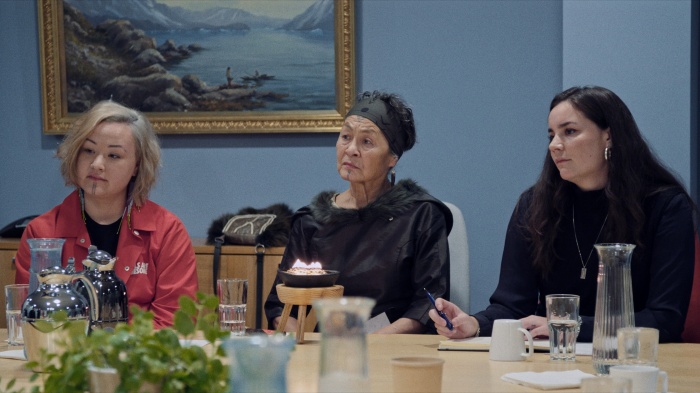
A still from the film Twice Colonized
We have seen many films about the Holodomor. They are mostly journalistic films, with interviews and static footage of commenters, occasionally with reconstruction of certain events. Guillaume Ribot chose a different path in his film Seeds of Hunger: Ukraine 1933. The French documentary filmmaker used to make films about the events of the Second World War: about a Jewish girl sent to Auschwitz, about Treblinka, about silencing the Holocaust in the USSR.
This time Ribot gave the narrative over to one of the best informed and most honest witnesses of the Great Hunger, the Welsh journalist Gareth Jones (13 August 1905–12 August 1935). It is worth remembering that Jones was the first one to speak about the mass hunger in the USSR, including the Holodomor, in Western press under his own name. His reports were printed by influential publications such as The Guardian and The New York Post.
Excerpts from Jones’ memoirs, diaries and articles are read out in English in voiceover; they are accompanied by letters from then-secretary of the Italian Embassy in the USSR and fragments of Soviet directives and decrees. Visually, Ribot composed the story from Soviet footage of those years: feature films and documentaries, newsreels, propaganda, photographs. The result is a dynamic and at the same time horrifying story about the Soviet government’s biggest crime in Ukraine. Ribot examines all its aspects in detail: causes, methods of implementation, the scale of the catastrophe. Exploiting the total plunder of the Ukrainian countryside, Stalin sought to rapidly industrialise the country—the results, however, proved to be miserable. As Jones noted, he managed to have a conversation with a tractor factory worker who admitted that the five-year plan was a fiction, and half of their 80 tractors were defective.
The mesmerising and sinister flow of images ends in poignant footage of an apple orchard from Earth by Dovzhenko. Guillaume Ribot has managed an attentive and respectful perspective on the Holodomor. And most importantly, the film, made in the universal style of edited cinema and voiced in English, must be perfectly understandable for the Western audience.
A still from the film Seeds of Hunger: Ukraine 1933
Gorgona is Europe’s last agricultural penal colony. Located 19 miles off the Tuscan coast, this remote prison island is home to ninety inmates. From caring for livestock to farming the land, these men are offered the chance to learn a trade and life skills that can help them reintegrate into society. Mafia members or drug abusers are not sent to the island. The only free person whose ancestors lived here back in the 1800s is Luisa Sitti.
The film Gorgona starts with a conversation between the guard Carlo Mazzerbo and the inmates. Each has his own fate and his own charisma. Merging into the background with his camera, Tibaldi monitors the work and days of the island: road and equipment repairs, livestock grazing, sheep shearing, vineyard cultivation. All these men roughened by life do not shy away from a kind of philosophy (“Killed his wife? He was just unlucky”) or moments of tenderness: just look how an inmate cares for a lost fledgling, and how another one feeds a feeble lamb. Entire families are incarcerated here: the son and father Vincenzo and Antonio Palumbo used to go on robberies together, and they serve their sentence together. Everyone more or less understands why they are here. Faith in a better future, even in a miracle is also present: they discuss an Indian who managed to save up so much money over the years of his incarceration that when he went back to India he was able to buy 5 or 6 hotels. The only disgruntled inmate is Rustam Zagirov: he believes that he is locked up unfairly, that the Italian justice system is corrupt, and that Gorgona is hell because he has not eaten any fish here even once. It is not surprising then to see the Russian flag and the portrait of Putin in his cell.
Along the edges of this routine, Luisa, an elderly noble signora, walks in silence: she just lives there, works in the kitchen, visits the graves of her ancestors. For her, just like for the inmates, time has stopped.
On 7 July 2007 in Tehran, a beginner designer, 19-year-old Reyhaneh Jabbari had a business meeting with a new client, plastic surgeon Sarbandi. The doctor said he wanted to make a new master plan for his clinic, but instead he brought the girl to his house and tried to rape her. She stabbed him in self-defence and escaped. Sarabandi died of the wounds. The same day, Reyhaneh was arrested and later charged with murder. Despite ample evidence of self-defence, Reyhaneh had no chance in court, since Sarabandi was a big shot in the secret service and had many friends in the Islamic Revolutionary Guard, a kind of KGB mixed with Gestapo, but in an Iranian way. Reyhaneh was eventually given a death sentence and, according to an inhumane custom, the sentence must be carried out by the murdered man’s family members.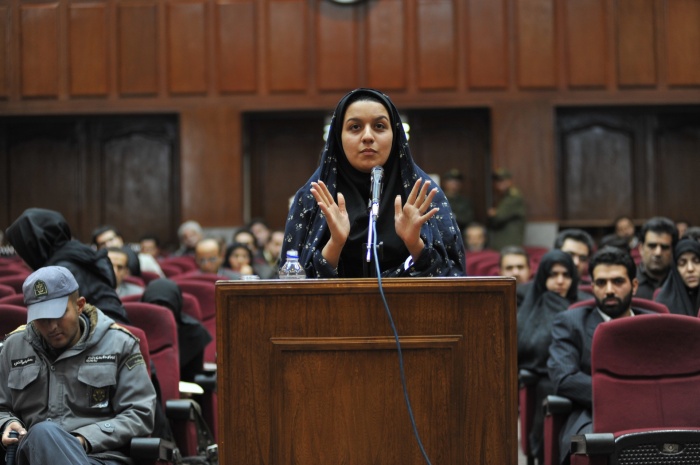
The film Seven Winters in Tehran is created thanks to hidden cameras and secretly recorded footage which was later transported out of the country. Steffi Niederzoll actively uses the family video archive as well as newsreels and interviews with Reyhaneh’s mother, father and sisters. The dictatorship organises a show trial to intimidate women; instead, the young Reyhaneh behind bars becomes a symbol and leader of resistance. The filmmaker constructs another, equally dramatic story about how the regime pits people against one another, because the person to knock the chair from under Reyhaneh’s feet must be surgeon Sarbandi’s eldest son, Jalal. The young man faces enormous pressure, and the trial becomes a nightmare for him.
Reyhaneh left this life with her head held high, and her mother and sisters continued her fight which helped save dozens of lives.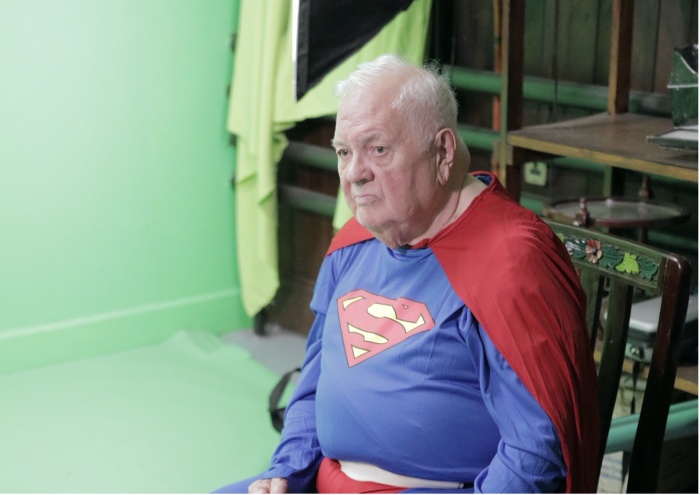
A still from the film A Bunch of Amateurs
The film A Bunch of Amateurs begins with a quote from Susan Sontag: “If cinephilia is dead, then movies are dead too.” In the Golden Age of Hollywood, many amateur film clubs sprang up all around Northern England. The Bradford Movie Makers, founded in 1928 and thus the oldest film club in Europe, is the only one still surviving.One could ask, what can be interesting about a half-decayed two-storey building topped with a weathervane shaped like half a carcass of some kind of cattle?
But this blessed place is the heart of true faith, love and joy. It is essentially a church of cinema. Funny and beautiful people, mostly retired and middle-aged, come here. They endlessly drink tea, row and make peace, and chain-watch movies — from the mid-1950s cowboy musical Oklahoma to James Cameron’s Avatar. But their faith takes them further: they go on to make films themselves. The resulting films have titles that sound like music: Appointment in Walthamstow, Return from Walthamstow, Nice Jam, Wicked and Lazy, Ghostly Turnip, It Came from Elsewhere. Watching the tricks employed by the fighters of the Bradford Movie Makers club to make these truly impressive films is its own pleasure.
Of course, everyone has their own burden in life. The lives of the club’s old-timers Colin and Harry die during the filming of Hopkins’s Documentary. Phil, the invariable special effects designer and cinematographer, is caring for his brother with cerebral palsy and does not have a family of his own. But cinema seems to be the best cure for trouble for all of them. And when the club faces the threat of closure due to debt, we must be sure that it will all end well. Because that’s fair.
In essence, Hopkins made a film in honour of cinephilia. Which still exists, so movies will also exist.
A still from the film A Silent Story
A Silent Story begins with information equally unpleasant and silenced by society: almost a third of cases of sexual violence against children and teenagers are committed by other children and teenagers.The director and protagonist of the film Anders Skovbjerg Jepsen is a survivor of this experience. During summer holidays, a son of family friends, 12-year-old Peter, was a frequent guest at their house. And he forced 6-year-old Anders to engage in sexual activities, exploiting the boy’s compliance and weakness. It lasted for six years, every summer. Nobody noticed it, and none of the two boys told anyone about it.
And although the abuse ended a long time ago, Anders felt the consequences of those events his whole life. He had erectile dysfunction, panic attacks, bouts of paranoia. And eventually he decided to deal with the trauma in a very brave way.Anders contacted Peter to talk to him directly about what happened when they were children. And to film it while ensuring Peter’s anonymity. Surprisingly, Peter agrees, because what he did actually torments him as well.
Everyone has something to say, everyone has accumulated enormous amounts of pain. This goes for both protagonists as well as for Anders’s father, who left the family when Anders was still a kid. Although the director is both the subject and the object of the narrative, he places the emphases very precisely and constructs the story rhythmically. The scene where Anders and his father go fishing and talk about what happened many years ago, an episode in the dark film studio when Anders launches an old video game for Peter during which a rape took place—these episodes are deeply impactful.
Jepsen’s debut is a striking therapy session using the means of cinema. In the end, everyone finds — if not healing, then at least the direction towards it.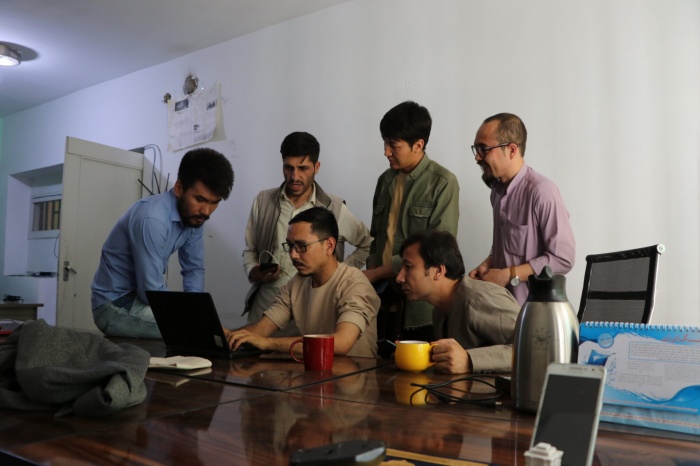
A still from the film the Etilaat Roz
For ten years, the journalists of The Etilaat Roz make Kabul’s most widely read daily newspaper based on the principles of complete transparency, constantly looking for abuses in society and politics. But what can they do when their work becomes practically impossible?
The newspaper office became a fortress between August and October 2021, when the US withdrew troops from Afghanistan and the Taliban took over the country again. Work continues, to the extent it is possible, to the sound of jets and gunfire in the background. The editor-in-chief, Zaki Daryabi, who always fights for the truest stories and for the safety of his employees, is growing more and more concerned. Bank accounts are blocked, censorship is introduced, journalists are attacked in the streets. The new government traditionally dislakes the latter, and Daryabi and his 50 brave colleagues face a difficult choice: should they continue to do journalism under the threat of torture, imprisonment and death? Can they even continue to live in their country?